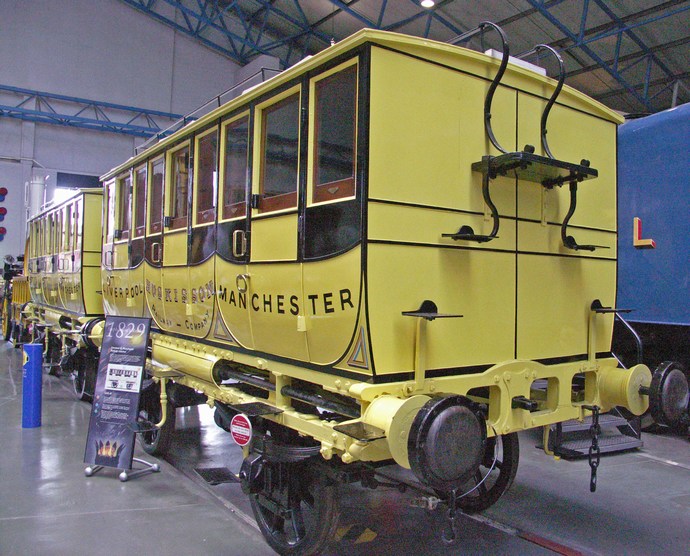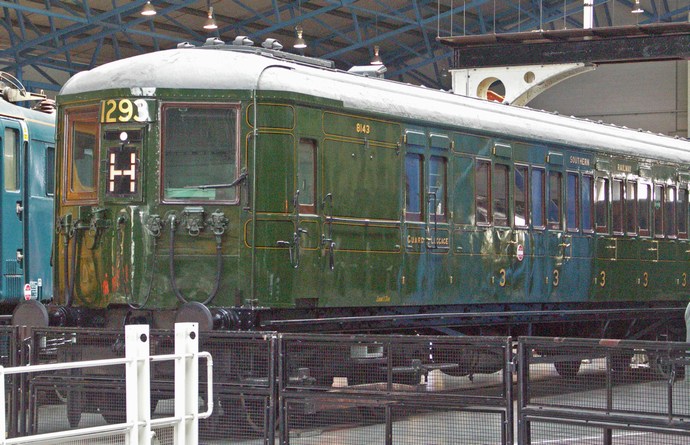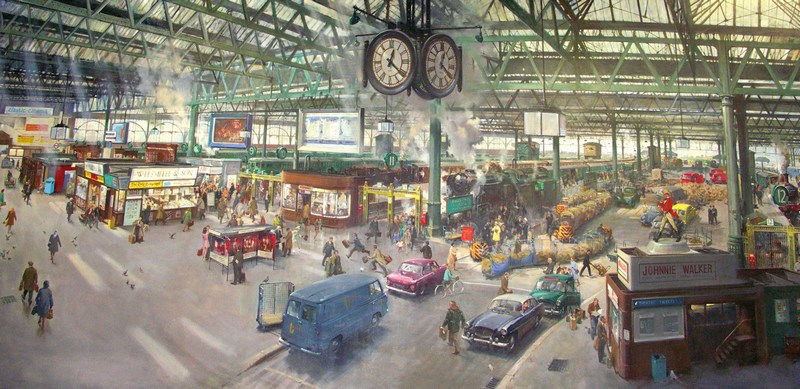| My Photographs | Links Page |
|
|
THE NATIONAL RAILWAY MUSEUM, YORK, 2009 |
|
The National Railway Museum opened in 1975. Until this time, the railway collection had partly been housed in the British Transport Museum, Clapham, London, and the existing York Railway Museum. The Science museum in London had started a railway collection as early as 1866 when it acquired the "Rocket". During the first half of the 20th century, most of the railway companies collected historical artifacts, but following on from nationalisation, a curator of railway relics was appointed in 1951. A collecting policy was initiated in order to increase the nation's collection of railway artefacts. Anything fitting the requirements of the policy and more importantly being relevant to telling the story of the train, could be listed for the collection. With a number of buildings already containing features for a National Railway Museum, the Leeman Road site in York, presented an ideal opportunity to house the National Collection. The Great Hall had the history of being York’s North Motive Power Depot, which originally had 4 locomotive turntables. Station Hall was the main goods (freight) station for York, and the Works was the York Diesel Locomotive Depot until 1986. When in 1999 The Works, was opened, it made the museum three times the size it was when it opened in 1975. The success of The Works led, in part, to the Museum gaining the European Museum of the Year award in 2001. For more details, see http://www.nrm.org.uk/visitor/history.asp The following photographs were taken in April 2009. |
Replica of Robert Stephenson's locomotive, the "Rocket". The "Rocket" took part in the Rainhill Trials in October 1829. Ten locomotives were originally entered for the Trials, but only five turned up and two of these were withdrawn during the first couple of days of the trials. A further two suffered mechanical problems, and by the third day, the "Rocket" was the only locomotive left in the competition. That day it covered 35 miles in 3 hours 12 minutes. Hauling 13 tons of loaded wagons, the "Rocket" averaged over 12 mph. On one trip it reached 25 mph and on a locomotive-only run, 29 mph. |
The replica "Rocket" with reproduction carriages.
At the end of the Trial, the owners of the
"Rocket" were awarded the £500 first prize.
The contract to produce locomotives for the Liverpool & Manchester Railway
went to the Robert Stephenson Company at Newcastle-upon-Tyne.
The original "Rocket" is preserved in the Science Museum in London.

Close up of the Rocket's reproduction carriages in Liverpool & Manchester Railway Company livery.
Replica of the
"Iron Duke", designed and built by Daniel Gooch for Brunel's Great
Western Railway in 1847.
The locomotive could haul trains from Paddington (London) to Bristol and Exeter
at speeds up to 60 mph.
By 1855 Gooch had produced twenty-one locomotives in this style.
The Iron Duke was built to fit Brunel's 7 foot-gauge railway.
(Standard gauge is 4 foot 8½ inches)
The broad gauge was converted to standard gauge over one weekend in May 1892.
The Iron Duke class of locomotives, were all scrapped. No originals
survive.
"Gladstone", London, Brighton & South Coast
Railway 0-4-2 Express Passenger Locomotive.
It was built at the LB&SCR works, Brighton in 1882 to a William Stroudley
design.
It was withdrawn in 1926 and taken into preservation by the Stephenson
Locomotive
Society - the first ever locomotive to be preserved by a private group of
people.
London
& North Western Railway 2-4-0 locomotive number 790 "Hardwicke".
This locomotive, built at Crewe Works in 1892, is the only surviving locomotive
to be designed by Francis Webb,
chief mechanical engineer on the London & North Western Railway.
The engine was used on the railway until 1932, and completed over 1 million
miles.
737 South East & Chatham Railway 4-4-0.
She was built in 1901 at Ashford, Kent, and taken into preservation in 1956.
During their active life, the 51 locos in the class, were frequently used for
the
boat train services between London and Folkestone and Dover.
4468 LNER
4-6-2 A4 class "Mallard".
Built in 1938 at Doncaster, "Mallard" holds the world
speed record for a steam locomotive.
The record was set on the 3rd July 1938 when the locomotive was recorded
travelling at 126 mph
on a straight stretch of track between Grantham and Peterborough, and the record
remains unbroken.
"Mallard" was Designed by the LNER
Chief Mechanical Engineer Sir Nigel Gresley.
She was withdrawn from service in 1963. Today there are four of these A4s
preserved in the UK.
Southern Railway 4-6-2
Battle of Britain class No 34051 "Winston Churchill", built 1945.
These Light Pacific locomotives were designed by Oliver Bulleid.
The flat paneling (air smoothing)
over the boiler lead to them being nicknamed "spam cans".
They were withdrawn from service at the end of steam on
British Railways (1967/8), but
nine of the Battle of Britain class are preserved in museums or heritage
railways.
Fittingly, this locomotive was employed to haul the funeral train of the late Sir Winston Churchill in January 1965.
London & North Western Railway electric multiple unit
motor coach.
It was used on the Broad Street (London) to Richmond service following
electrification in 1916.
The bodywork was made by Metropolitan Carriage of Birmingham, with electric
motors from Switzerland.
1937 Southern Electric Motor Open Third Brake (4-COR)
Portsmouth Unit.
These express EMUs were built at Eastleigh works for the newly-electrified
Waterloo to Portsmouth line.
Work on electrification of the Portsmouth route began in 1935. Full
passenger services commenced on 4th July 1937.

1925 Southern Electric suburban Motor Third Brake (4-SUB)
These trains were used in the western suburban area of Southern (out of
Waterloo), which was electrified in 1925.
They were built by Metropolitan Carriage of Birmingham, with motors from
Metropolitan-Vickers.

Mural of Waterloo Station in early 1960s.
The mural can be seen in the Station Hall at the NRM, York.
| My Photographs | Links Page |
© Copyright M J Smith, 2009
No photographs to be reproduced elsewhere without permission.